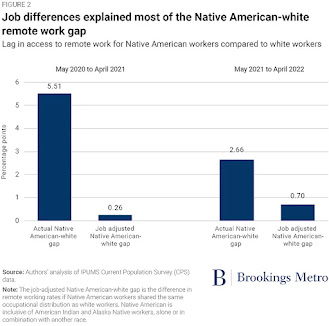 |
| Difference in remote work by Native Americans and whites (Graph by the Brookings Institution; to enlarge, click on it) |
In early summer 2020, Census Bureau data showed that "Native Americans worked remotely due to the pandemic at a rate 8 percentage points lower than white workers," they write. "As workers returned to the office in 2021 and 2022, that gap closed but never disappeared, and by early summer 2022, Native Americans were still working remotely due to the pandemic at a rate 2 percentage points lower than white workers."
Gregg and Maxim write, "It’s impossible to say with full confidence what factors are driving this disparity" but offer a few potential causes. More than any other racial group, Native Americans live in overcrowded housing, potentially making it hard to find a good workspace at home. Native American communities, especially rural ones, are also underserved by internet providers. They also likely face greater employment discrimination in the larger job market which would effect their ability to find remote jobs.
"In sum, rather than unlocking new opportunities for Native American workers to connect with far-flung employers via remote work, the pandemic instead seems to have entrenched existing labor market inequalities. This demonstrates the urgent need for the federal government to live up to its trust and treaty obligations to Native nations, particularly in the areas of economic development and education."
No comments:
Post a Comment